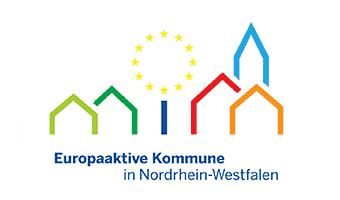Inhalt
Historischer Rundweg - Board 5
Alte Schmiede
A culture house in which art shows, readings, cultural and music events are held.
Balcksmith’s craft
The blacksmith’s craft is one of the oldest crafts ever. Every village had its own blacksmith. In rural areas the blacksmith, up until the end of the 20th century, was of great importance due to his multiple talents, for example in repairing carriages, carts and farming equipment, for shodding horses, for doing metalwork and as a toolmaker.
Around 1900 there were all-told five blacksmiths, not far from one another in Weeze’s town centre, alone on Schmiedestrasse there were three. Above all it was the farming community who were reliant on the blacksmith for their horses and carriages. They had them repair worn harnesses and more regularly had them shod their working horses.
Blacksmith Kerns
At the end of the 19th century the blacksmith of Theodor Kerns was built on the Wasserstrasse and was run later by his son Matthias Kerns. In the blacksmith’s there was an oven with three hearths, a bellows and an anvil a hundred years ago. A blacksmith’s fire burned up to three tons of coal and the bellows measured about 2 metres in length. On top of that the blacksmith had so-called drop forges, blacksmith’s forms for profiles, a press or bending-machine for shaping cartwheels and a compressing machine for wheels that were too big. The workforce consisted of four to five men. Only iron was available for the work and everything was more-or-less made manually. For chains, for example, the pegs, catches, emergency links, s-links and everything else required for the chains were made by the blacksmith. For shodding horses there was a shodding stall, commonly known as the “Nöttestall”. Apart from that one-axle carts with big wheels were also built in Kerns smithy.
Rebuilding
After the closure of the smithy in February 1968 the building was simply used as a storage space and grew in disrepair. In order to stop its complete decay the centrally-located building was, at the beginning of 2004, purchased by the Municipality of Weeze. The rebuilding began with a large number of voluntary helpers and donations from private persons and companies. Since July 2004, under the motto “from Weeze’s citizens for Weeze”, the work was quickly initiated and done, so that in November 2005 the official opening ceremony for the refurbished building could be held.
Usage
The historical workplace in the middle of Weeze’s town centre developed into a meeting-point for the whole of Weeze’s population. It became a culture house where art exhibitions, public readings and music events are held on a regular basis. The smithy with its pleasant ambience with hearth, bellows, transmission equipment and a diversity of blacksmith’s tools is also used for registrar weddings and actively integrated into events in the town centre. Above all the building is available for use by Weeze’s clubs and associations.
Workers (wearing leather aprons) from Kerns blacksmith’s standing on Wasserstrasse, view of the Wasserstrasse from the west in the direction of the market, postcard-view, around 1910.
Since 1968 the smithy building fell more and more into disrepair until the Municipality of Weeze purchased it in 2004.
With the help of the A-youth football team of TSV Weeze and other volunteers the roof was quickly completed. (2005)
„Alte Schmiede“ (old blacksmith’s). The two bricked gate posts are still visible today. The left half of the yard was covered by a roof, this is where the shodding stall stood and is where the horses were shod. The workplace was expanded in the 1920’s, as is still visible today. From left to right: Heinrich Belting (Weeze’s coppersmith and plumber), two unknown journeymen (trainees), Theodor Weigand (master painter), Heinrich Verhülsdonk (owner of the pub on Kirchplatz/corner LoKirchplatz/corner Loëstrasse) and blacksmith Theodor Kerns, postcard-view from around 1910.


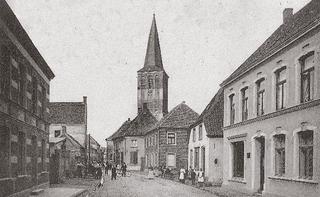
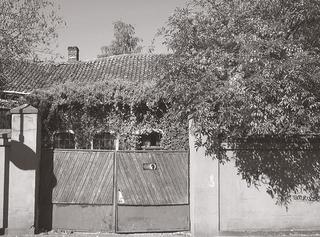
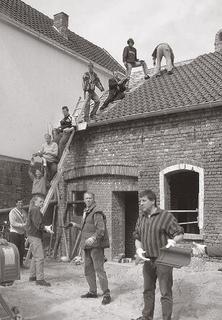
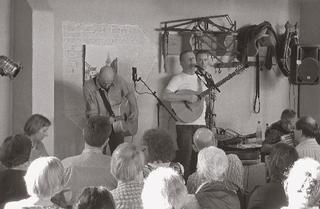
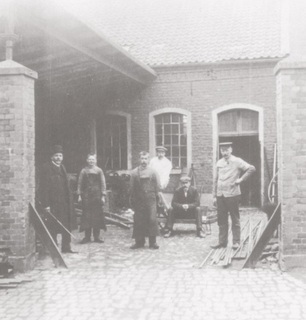
 02837 9100 (Zentrale)
02837 9100 (Zentrale) info@weeze.de
info@weeze.de Facebook
Facebook